Layered Intrusions of Paleoproterozoic Age in the Kola and Karelian Regions
Abstract
1. Introduction
2. Geologic Setting
3. Analytical Methods
4. Geochemistry
5. Discussion
5.1. Comparative Analysis of Geochemical and Isotopic Data
5.2. S Isotope Analysis
5.3. Layered Intrusion Formation Pattern
6. Conclusions
Supplementary Materials
Author Contributions
Funding
Data Availability Statement
Acknowledgments
Conflicts of Interest
References
- Smolkin, V.F.; Mokrushin, A.V. Paleoproterozoic Layered Intrusions of the Monchegorsk Ore District: Geochemisrty and U-Pb, Sm-Nd, Re-Os Isotope Analysis. Minerals 2022, 12, 1432. [Google Scholar] [CrossRef]
- Sharkov, E.V. Petrology of Layered Intrusions; Nauka: Leningrad, Russia, 1980; 184p. (In Russian) [Google Scholar]
- Sharkov, E.V. Formation of Layered Intrusions and Related Mineralization; Scientific World: Moscow, Russia, 2006; 364p. (In Russian) [Google Scholar]
- Alapieti, T.T.; Filen, B.A.; Lahtinen, J.J.; Lavrov, M.M.; Smolkin, V.F.; Voitsekhovsky, S.N. Early Proterozoic layered intrusion in the northeastern part of the Fennoscandian Shield. Miner. Petrol. 1990, 42, 1–22. [Google Scholar] [CrossRef]
- Sharkov, E.V.; Smolkin, V.F. Palaeoproterozoic layered intrusions of the Russian part of the Fennoscandian Shield: A review. Trans. Inst. Min. Metall. Sect. B Appl. Earth Sci. 1998, 107, B23–B38. [Google Scholar]
- Smolkin, V.F. The Paleoproterozoic (2.5–1.7 Ga) midcontinent rift system of the northeastern Fennoscandian Shield. Can. J. Earth Sci. 1997, 34, 426–443. [Google Scholar] [CrossRef]
- Smolkin, V.F.; Fedotov, Z.A.; Neradovsky, Y.N.; Bayanova, T.B.; Borisova, V.V.; Glaznev, V.N.; Dedyukhin, A.N.; Orsoev, D.A.; Ohnenstetter, M.; Ohnenstetter, D.; et al. Layered Intrusions of the Monchegorsk Ore Region: Petrology, Mineralization, Isotope Features and Deep Structure, 1st Part; Mitrofanov, F.P., Smolkin, V.F., Eds.; KSC RAS: Apatity, Russia, 2004; 177p. (In Russian) [Google Scholar]
- Smolkin, V.F.; Fedotov, Z.A.; Neradovsky, Y.N.; Bayanova, T.B.; Borisova, V.V.; Glaznev, V.N.; Dedyukhin, A.N.; Orsoev, D.A.; Ohnenstetter, M.; Ohnenstetter, D.; et al. Layered Intrusions of the Monchegorsk Ore Region: Petrology, Mineralization, Isotope Features and Deep Structure, 2nd Part; Mitrofanov, F.P., Smolkin, V.F., Eds.; KSC RAS: Apatity, Russia, 2004; 177p. (In Russian) [Google Scholar]
- Smolkin, V.F.; Kremenetsky, A.A.; Vetrin, V.R.; Tessalina, S.G. A model of the ore-magmatic system formation of the Paleoproterozoic layered intrusions of the Baltic Shield. In Science and Education: Towards the 250th Anniversary of Geological Museum RAS; Nauka: Moscow, Russia, 2009; pp. 302–316. (In Russian) [Google Scholar]
- Sharkov, E.V.; Krassivskaya, I.S.; Chistyakov, A.V. Dispersed mafic-ultramafic intrusive magmatism in early Paleoproterozoic mobile zones of the Baltic Shield: An example of the Belomorian Drusite (Coronite) Complex. Petrology 2004, 12, 561–582. [Google Scholar]
- Mitrofanov, F.P.; Pozhilenko, V.I.; Arzamastsev, A.A.; Fedotov, Z.A.; Kolka, V.V.; Korsakova, O.P.; Lyubtsov, V.V.; Neradovsky, Y.N.; Skufin, P.K.; Smolkin, V.F.; et al. Major Geological Sights of the Kola Peninsula; Mitrofanov, F.P., Zozulya, D.R., Eds.; Geological Institute KSC RAS: Apatity, Russia, 2002; 150p. [Google Scholar]
- Bakushkin, E.M. Sulfide copper-nickel mineralization of the Mt.Generalskaya intrusion (Luostari Massif). In New Data on the Mineralogy of Copper Nickel and Copper Ores of the Kola Peninsula; KSC RAS: Apatity, Russia, 1979; pp. 79–84. (In Russian) [Google Scholar]
- Amelin, Y.V.; Heaman, L.M.; Semenov, V.S. U-Pb geochronology of layered intrusions in the eastern Baltic Shield: Implication for timing and duration of Paleoproterozoic continental rifting. Precambrian Res. 1995, 75, 31–46. [Google Scholar] [CrossRef]
- Bayanova, T.B.; Smolkin, V.F.; Levkovich, N.L.; Ryungenen, G.I. U-Pb age of rocks of the Mt. Generalskaya layered intrusion, Kola Peninsula. Geochem. Int. 1999, 37, 1–10. [Google Scholar]
- Balashov, Y.A.; Bayanova, T.B.; Mitrofanov, F.P. Isotopic data on the age genesis of layered basic-ultrabasic intrusions in the Kola Peninsula and Northern Karelia, northeastern Baltic Shield. Precambrian Res. 1993, 64, 197–205. [Google Scholar] [CrossRef]
- Revyako, N.; Anosova, M.; Kostitsyn, Y.; Bychkova, Y. U-Pb dating of zircon, Rb-Sr and Sm-Nd isotopic analysis of layered intrusion Kivakka. In Proceedings of the Goldschmidt Conference, Knoxville, TN, USA, 13–18 June 2010. [Google Scholar]
- Amelin, Y.V.; Semenov, V.S. Nd and Sr isotope geochemistry of mafic layered intrusions in the eastern Baltic Shield: Implication for sources and contamination of Paleoproterosoic continental mafic magmas. Contrib. Mineral. Petrol. 1996, 124, 255–272. [Google Scholar] [CrossRef]
- Bailly, L.; Augé, T.; Cocherie, A.; Trofimov, N.N.; Golubev, A.I.; Tkachev, A.V.; Cherkasov, S.V. New data on the age of the Burakovsky layered intrusion, Karelia. Dokl. Earth Sci. 2009, 426, 534–538. [Google Scholar] [CrossRef]
- Chistyakov, A.V.; Sharkov, E.V. Petrology of the Early Paleoproterozoic Burakovsky Complex, Southern Karelia. Petrology 2008, 16, 63–86. [Google Scholar] [CrossRef]
- Efimov, A.A.; Kaulina, T.V. Geological features and U-Pb dating (first data) of rocks of the southeastern part of the Kovdozersky gabbro-peridotite complex. In Proceedings of the International Conference, Belomorian Mobile Belt (Geology, Geodynamics, Geochronology), Petrozavodsk, Russia, 1–4 September 1997. (In Russian). [Google Scholar]
- Mezhelovskaya, S.V.; Korsakov, A.K.; Mezhelovskii, A.D.; Bibikova, E.V. Age range of formation of sedimentaryvolcanogenic complex of the Vetreny Belt (the southeast of the Baltic Shield). Stratigr. Geol. Correl. 2016, 24, 105–117. [Google Scholar] [CrossRef]
- Kulikov, V.S.; Kulikova, V.V.; Bychkova, Y.V.; Kostitsyn, Y.A.; Vasilev, M.V.; Pokrovsky, O.S. The Ruiga intrusion: A typical example of a shallow-facies Paleoproterozoic peridotite-gabbro-komatiite-basaltic association of the Vetreny Belt, South-Eastern Fennoscandia. Petrology 2008, 16, 531–551. [Google Scholar] [CrossRef]
- Smol’kin, V.F.; Mezhelovskaya, S.V.; Mezhelovsky, A.D. The sources of the clastic material of the terrigenous sequences of the neoarchean and paleoproterozoic paleobasins in the eastern part of the Fennoscandian Shield based on isotope analysis data for detrital zircons (SIMS, LA-ICP-MS). Stratigr. Geol. Correl. 2020, 28, 571–602. [Google Scholar] [CrossRef]
- Grokhovskaya, T.L.; Sharkov, E.V.; Tevelev, A.V.; Smolkin, V.F.; Chistyakov, A.V.; Chistyakov, A.V.; Laputina, I.P.; Muravitskya, G.N. Petrology of the Mount General’skaya layered intrusion, Kola Peninsula. Petrology 1999, 7, 509–526. [Google Scholar]
- Grokhovskaya, T.L.; Laputina, I.P.; Kuznetsov, G.S.; Muravitskaya, G.N.; Sokolov, S.V.; Telnov, V.A.; Bolshakov, A.N. Platinum-copper-nickel mineralization of the stratified intrusive of the Generalskaya Mountain (Pechengsky ore district, Kola Peninsula). Geol. Ore Depos. 1996, 38, 211–225. [Google Scholar]
- Bychkova, Y.V. Regularities of Structure of Contrast Rhythmic Layering in Kivakka Intrusion. Ph.D. Thesis, MSU, Moscow, Russia, 14 November 2003. (In Russian). [Google Scholar]
- Bychkova, Y.V.; Mikliaeva, E.P.; Koptev-Dvornikov, E.V.; Borisova, A.Y.; Bychkov, A.Y.; Minervina, E.A. Proterozoic Kivakka layered mafic-ultramafic intrusion, Northern Karelia, Russia: Implications for the origin of granophyres of the upper boundary group. Precambrian Res. 2019, 331, 105381. [Google Scholar] [CrossRef]
- Barkov, A.Y.; Nikiforov, A.A. A new criterion for searching for platinum-metal mineralization of the Kivakka Reef type. Vestnik VSU 2015, 4, 75–83. (In Russian) [Google Scholar]
- Koptev-Dvornikov, E.V.; Yaroshevsky, A.A.; Veis, V.A. Directional crystallization is not a mechanism of magmatic evolution. Bull. Dep. Earth Sci. RAS 2011, 3, NZ6040. [Google Scholar] [CrossRef]
- Mikhailov, V.P.; Leontiev, A.G.; Golovanov, Y.B.; Yartsev, V.M.; Ushkov, V.V.; Ruchjeva, N.P.; Degtiareva, T.A.; Fedyuk, Z.N.; Borisova, R.I.; Shchiptsov, V.V.; et al. Mineral and Raw Material Base of the Republic Karelia. Book 1. Combustible Mineral Resources. Metallic Mineral Resources; Mikhailov, V.P., Aminov, V.N., Eds.; IG KarSC RAS: Petrozavodsk, Russia, 2005; 278p. (In Russian) [Google Scholar]
- Smol’kin, V.F. Early Proterozoic. In Early Precambrian of the Baltic Shield; Glebovitsky, V.A., Ed.; Nauka: St. Petersburg, Russia, 1992; pp. 59–123. (In Russian) [Google Scholar]
- Chistyakov, A.V.; Sharkov, E.V.; Grokhovskaya, T.L.; Bogatikov, O.A.; Muravitskaya, G.N.; Grinevich, N.G. Petrology of the Europe-largest Burakovka early Paleoproterozoic layered pluton (Southern Karelia, Russia). Russ. J. Earth Sci. 2002, 4, 35–75. [Google Scholar] [CrossRef]
- Ganin, V.A.; Grinevich, N.G.; Loginov, V.N. Petrology and platinum content of the Burakovka-Aganozero intrusion (Eastern Zaonezhie). In Platinum of Russia, 2 Book; Geoinformmark Publishing Co.: Moscow, Russia, 1995; pp. 19–23. (In Russian) [Google Scholar]
- Lavrov, M.M.; Trofimov, N.N.; Golubev, A.I.; Slyusarev, V.D. Geology and petrology of the Burakovsky stratified intrusive. Otechestvennaya Geol. 2004, 2, 23–30. (In Russian) [Google Scholar]
- Sharkov, E.V.; Bogatikov, O.A.; Grokhovskaya, T.L.; Snyder, G.A.; Taylor, L.A. Petrology and Ni-Cu-Cr-PGE mineralization of the largest mafic pluton in Europe: The early proterozoic Burakovsky layered intrusion, Karelia, Russia. Int. Geol. Rev. 1995, 37, 509–525. [Google Scholar] [CrossRef]
- Berkovsky, A.N.; Semenov, V.S.; Belyatskii, B.V.; Korneev, S.I.; Yakovleva, O.A.; Grinevich, N.G. The structure of the Burakovo-Aganozero stratified complex: Petrological conclusions. Petrology 2000, 8, 585–606. [Google Scholar]
- Chistyakov, A.V. One of the largest in the eastern part of the Baltic Shield Avdeevskaya gabbronorite dyke as an integral part of the Early Proterozoic Burakovsky complex of Karelia: Geological and geochemical characteristics. In Proceedings of the III All-Russian Symposium on Volcanology and Paleovolcanology, Ulan-Ude, Russia, 5–8 September 2006. (In Russian). [Google Scholar]
- Stepanov, S.V. The Main Magmatism of the Precambrian of the Western White Sea; Nauka: Leningrad, Russia, 1981; 216p. (In Russian) [Google Scholar]
- Salnikova, E.B.; Stepanova, A.V.; Azimov, P.Y.; Sukhanova, M.A.; Kotov, A.B.; Egorova, S.V.; Plotkina, Y.V.; Tolmacheva, E.V.; Kervinen, A.V.; Rodionov, N.V.; et al. A History of coronitic metagabbronorites in the Belomorian Provine, Fennoscandian Shield: Dating U-Pb (CA-ID-TIMS) dating of the Zircon-Baddeleyite Aggregates. Petrology 2022, 30, 596–622. [Google Scholar] [CrossRef]
- Efimov, A.A. Geological Structure, Conditions of Formation and Platinum Bearing of the Kovdozersky Granite-Hyperbasite Massif (North-Western White Sea). Ph.D. Thesis, VSU, Voronezh, Russia, 1999. (In Russian). [Google Scholar]
- Efimov, A.A.; Bakushkin, E.M.; Pakhomovsky, Y.A. Reaction rims on the border of olivine and plagioclase in rocks of the Kovdozersky basite-hyperbasite massif and conditions of their genesis. Zapiski VMO 1997, 5, 83–92. (In Russian) [Google Scholar]
- Smolkin, V.F. Komatiite and Picrite Magmatism of the Early Precambrian of the Baltic Shield. Nauka: St. Petersburg, Russia, 1992; 272p. (In Russian) [Google Scholar]
- Girnis, A.V.; Ryabchikov, I.D.; Bogatikov, O.A. Genesis of Komatiites and Komatiite Basalts. Sharkov, E.V., Ed.; Nauka: Moscow, Russia, 1987; 121p. (In Russian) [Google Scholar]
- Kulikov, V.S.; Girnis, A.V.; Ryabchikov, I.D.; Kulikova, V.V.; Svetova, A.I.; Rayevskaya, M.B.; Gorkokvets, V.Y.; Vyakhirev, S.A. Komatiites and High-Magnesian Volcanites of the Early Precambrian of the Baltic Shield; Bogatikov, O.A., Ed.; Nauka: Leningrad, Russia, 1988; 192p. (In Russian) [Google Scholar]
- Evseeva, K.A.; Krasivskaya, I.S.; Chistyakov, A.V.; Sharkov, E.V. Early Paleoproterozoic boninite-like volcanites of the Windy belt in the eastern part of the Baltic Shield, Russia. Lithosphere 2004, 3, 110–126. (In Russian) [Google Scholar]
- Mezhelovskaya, S.V. Features of the Geological Structure and Time of Formation of the Sedimentary-Volcanogenic Complex of the Windy Belt (South-East of the Baltic Shield). Ph.D. Thesis, MSU, Moscow, Russia, 2016. (In Russian). [Google Scholar]
- Puchtel, I.S.; Touboul, M.; Blichert-Toft, J.; Walker, R.J.; Brandon, A.D.; Nicklas, R.W.; Kulikov, V.S.; Samsonov, A.V. Lithophile and siderophile element systematics of Earth’s mantle at the Archean– Proterozoic boundary: Evidence from 2.4 Ga komatiites. Geochim. Cosmochim. Acta 2016, 180, 227–255. [Google Scholar] [CrossRef]
- McDonough, W.F.; Sun, S.S. The composition of the Earth. Chem. Geol. 1995, 120, 222–253. [Google Scholar] [CrossRef]
- Salters, U.J.M.; Stracke, A. Composition of the depleted mantle. Geochem. Geophys. Geosystems 2004, 5, Q05B07. [Google Scholar] [CrossRef]
- Tolstikhin, I.N.; Dokuchaeva, V.S.; Kamensky, I.L.; Amelin, Y.V. Juvenile helium in ancient rocks II. U-He, K-Ar, Sm-Nd, and Rb-Sr systematics in the Monche Pluton: 3He/4He ratios frozen in uranium-free ultramafic rocks. Geochim. Cosmochim. Acta 1992, 56, 987–999. [Google Scholar] [CrossRef]
- Yang, S.-H.; Hanski, E.; Chao, L.; Maier, W.D.; Huhma, H.; Mokrushin, A.V.; Latypov, R.; Lahaye, Y.; O’Brien, H.; Qu, W.-J. Mantle source of the 2.44-2.50-Ga mantle plume-related magmatism in the Fennoscandian Shield: Evidence from Os, Nd, and Sr isotope compositions of the Monchepluton and Kemi intrusions. Miner. Depos. 2016, 51, 1055–1073. [Google Scholar] [CrossRef]
- Smolkin, V.F.; Mokrushin, A.V.; Bayanova, T.B.; Serov, P.A.; Ariskin, A.A. Magma feeder paleocanal in the Monchegorsky ore district: Geochemistry, isotopic U-Pb and Sm-Nd analysis (Kola region, Russia). J. Min. Inst. 2022, 255, 1–14. (In Russian) [Google Scholar] [CrossRef]
- Ilyina, V.P.; Frolov, P.V. Utilization of host rocks, e.g. serpentinite, recovered upon the integrated mining of a deposit. In Proceedings of the 16th International Multidisciplinary Scientific GeoConference, Albena, Bulgary, 30 June–6 July 2016. [Google Scholar]
- Bekker, A.; Grokhovskaya, T.L.; Hiebert, R.; Sharkov, E.V.; Bui, T.H.; Stadnek, K.R.; Chashchin, V.V.; Wing, B.A. Multiple sulfur isotope and mineralogical constraints on the genesis of Ni-Cu-PGE magmatic sulfide mineralization of the Monchegorsk Igneous Complex, Kola Peninsula, Russia. Miner. Depos. 2016, 51, 1035–1053. [Google Scholar] [CrossRef]
- Vysotskiy, S.V.; Orsoev, D.A.; Ignatiev, A.V.; Velivetskaia, T.A.; Aseeva, A.V. Sulfur source for Ni-Cu mineralization of Monchegorsk igneous complex (Kola Peninsula, Russin) by multiple isotope data. In Proceedings of the V International Conference “Ultramafic-Mafic Complexes: Geology, Structure, Ore Potencial”, Gremyachinsk, Russia, 2–6 September 2017. (In Russian). [Google Scholar]
- Vetrin, V.R. Composition and Structure of the Lower Crust of the Belomorian Mobile Belt, Baltic Shield. Petrology 2006, 14, 390–412. [Google Scholar] [CrossRef]
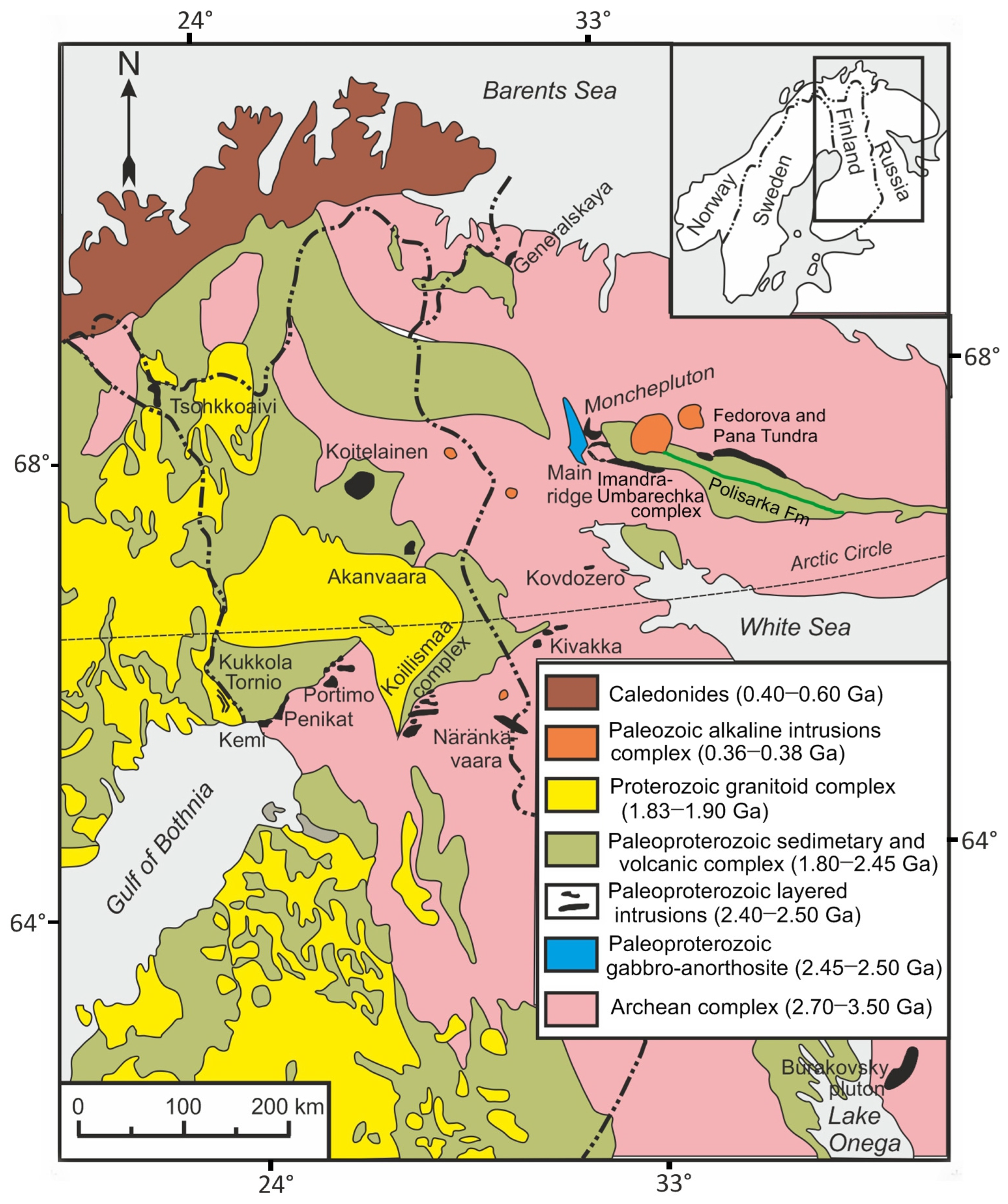
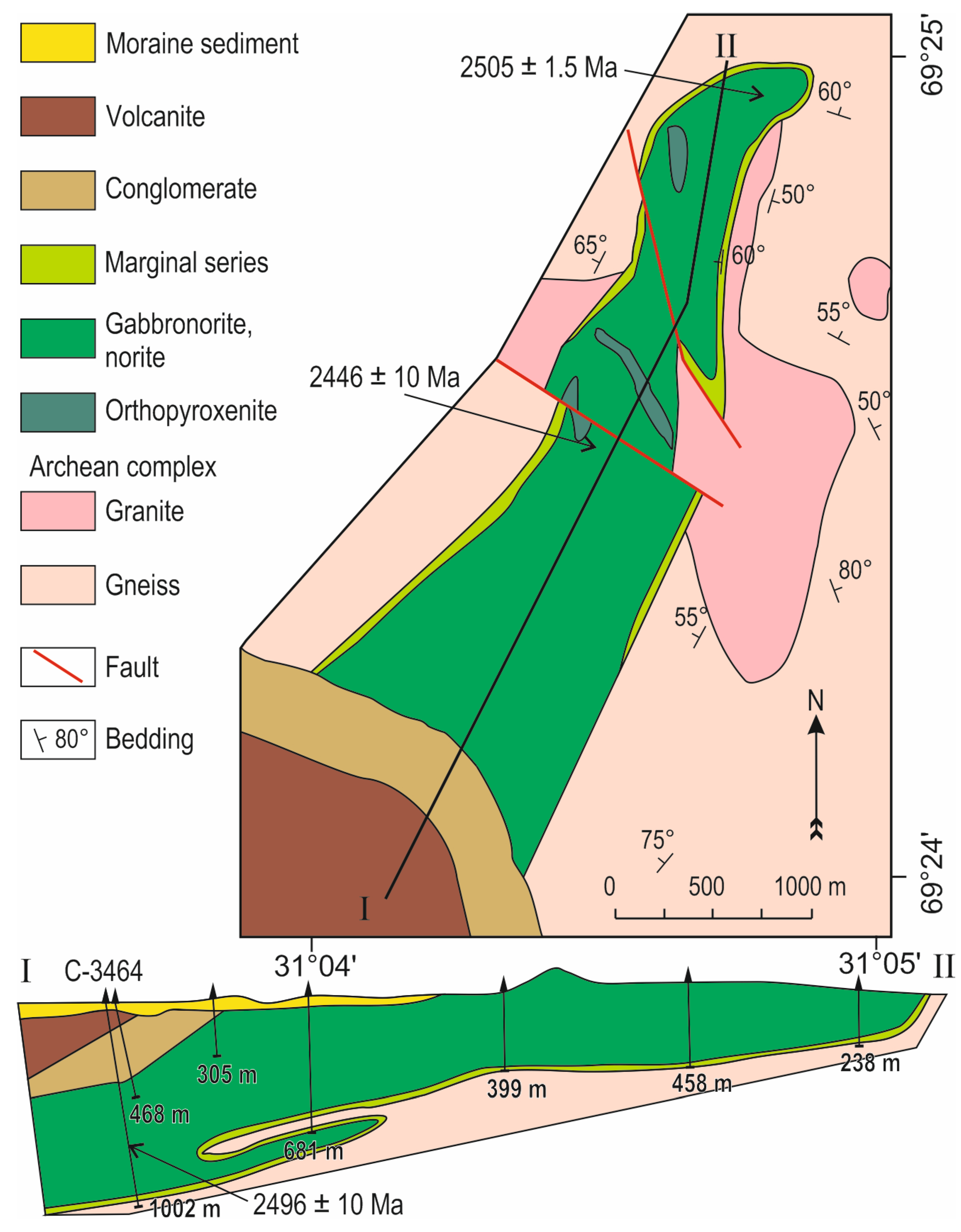
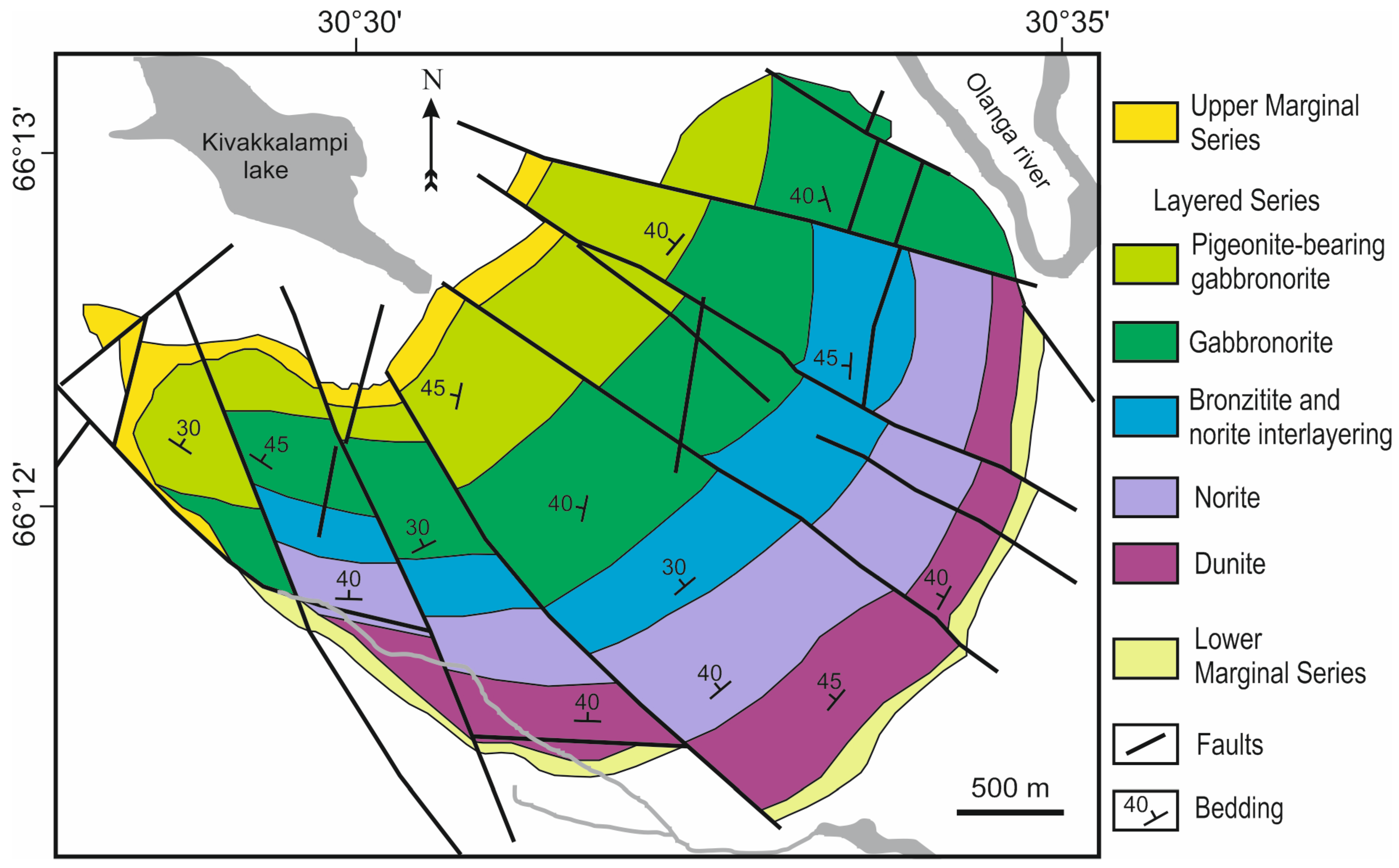


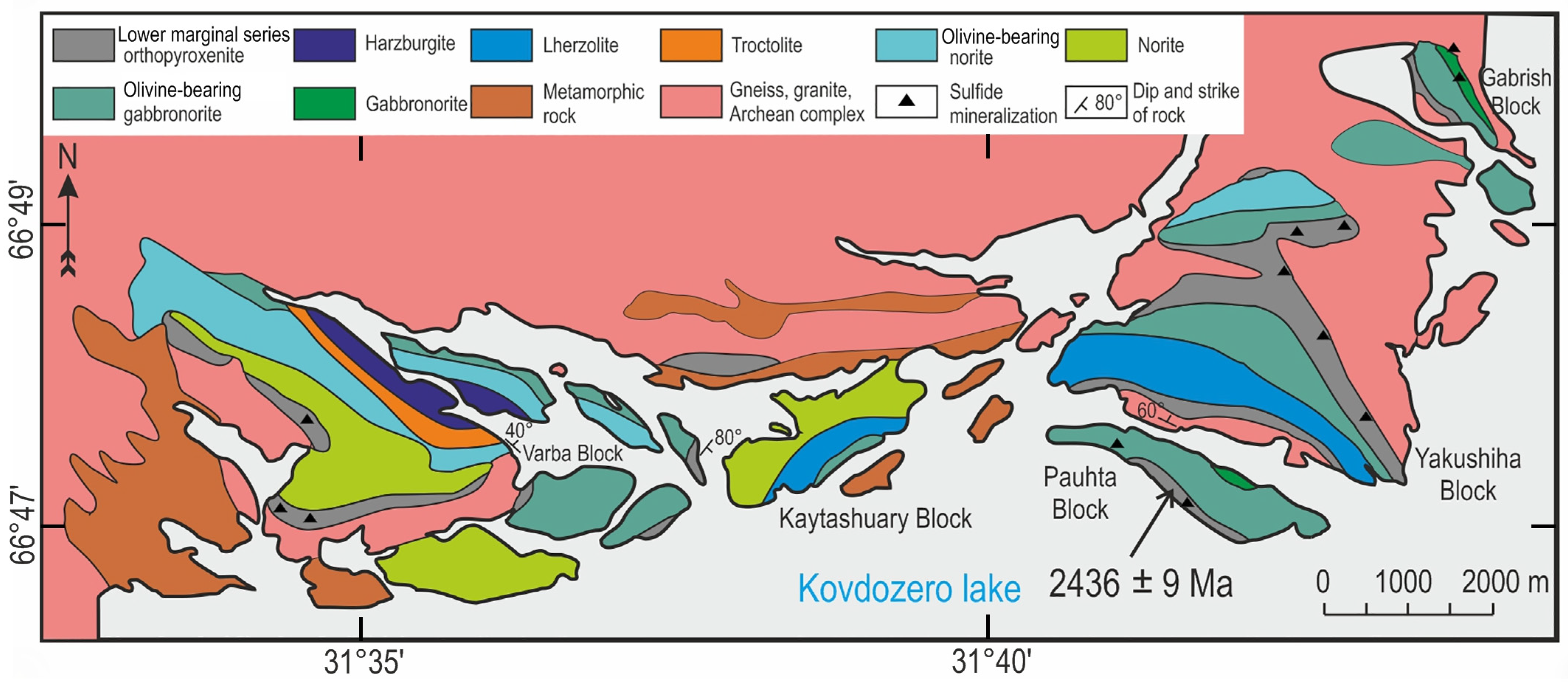
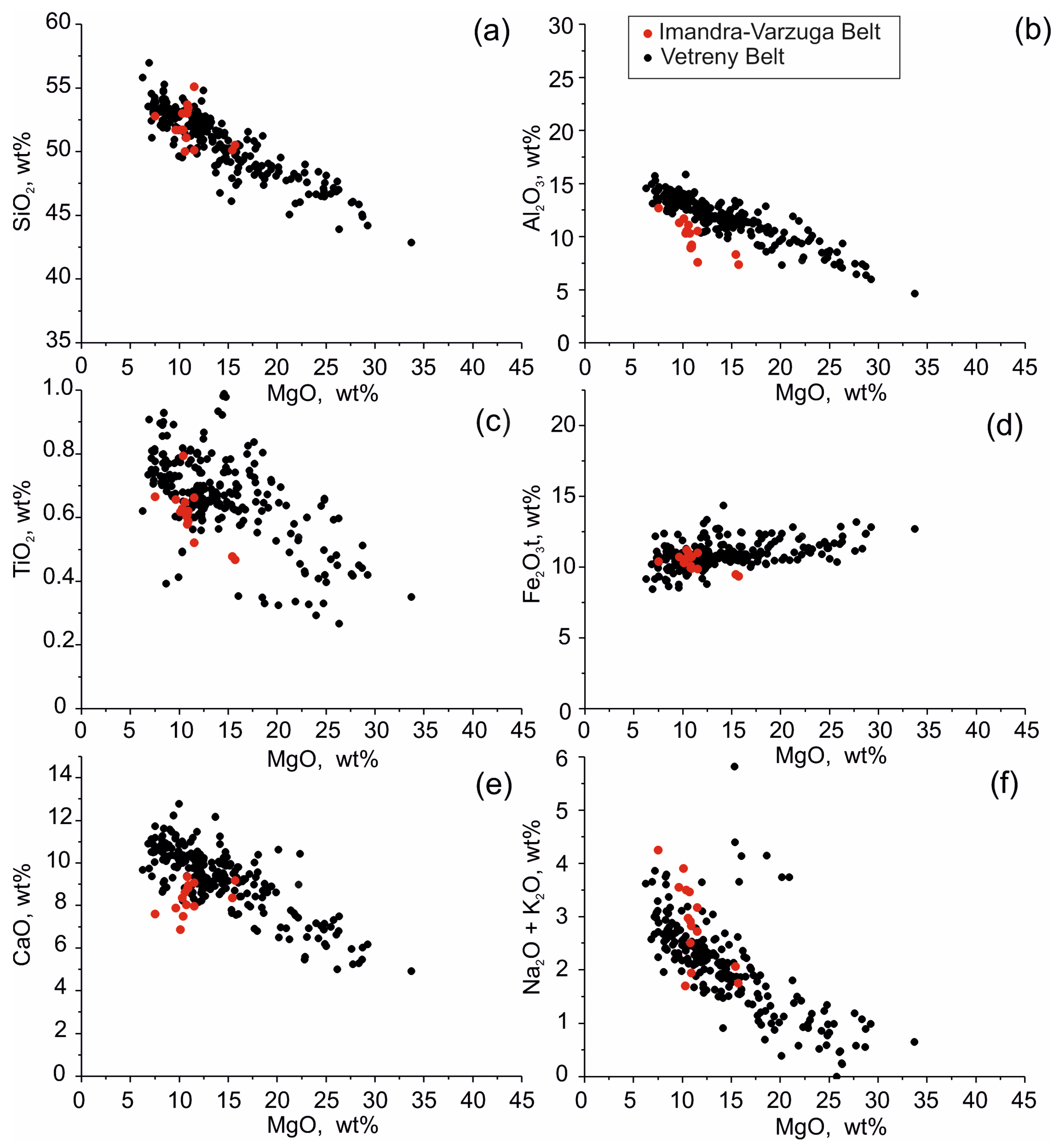
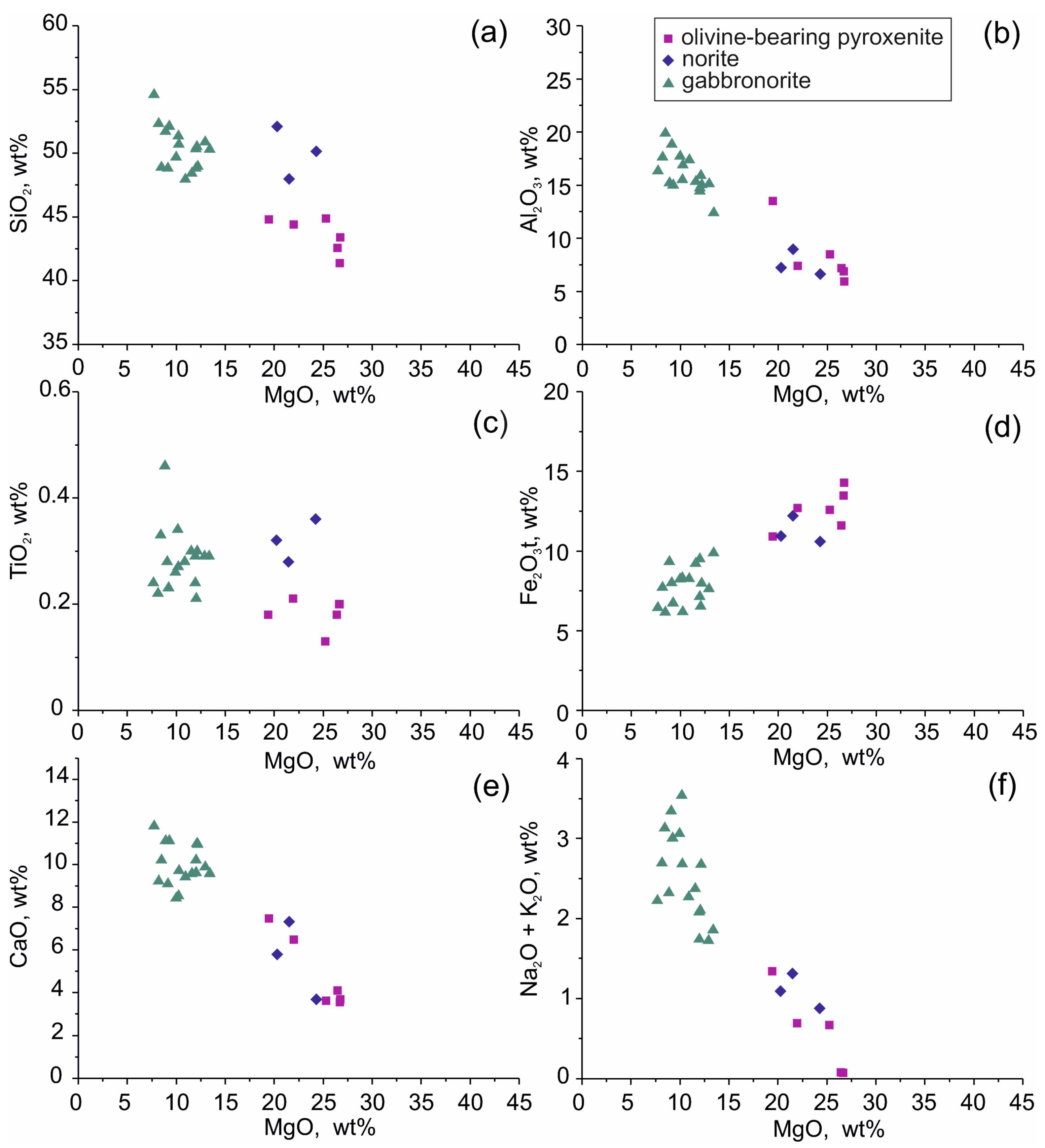
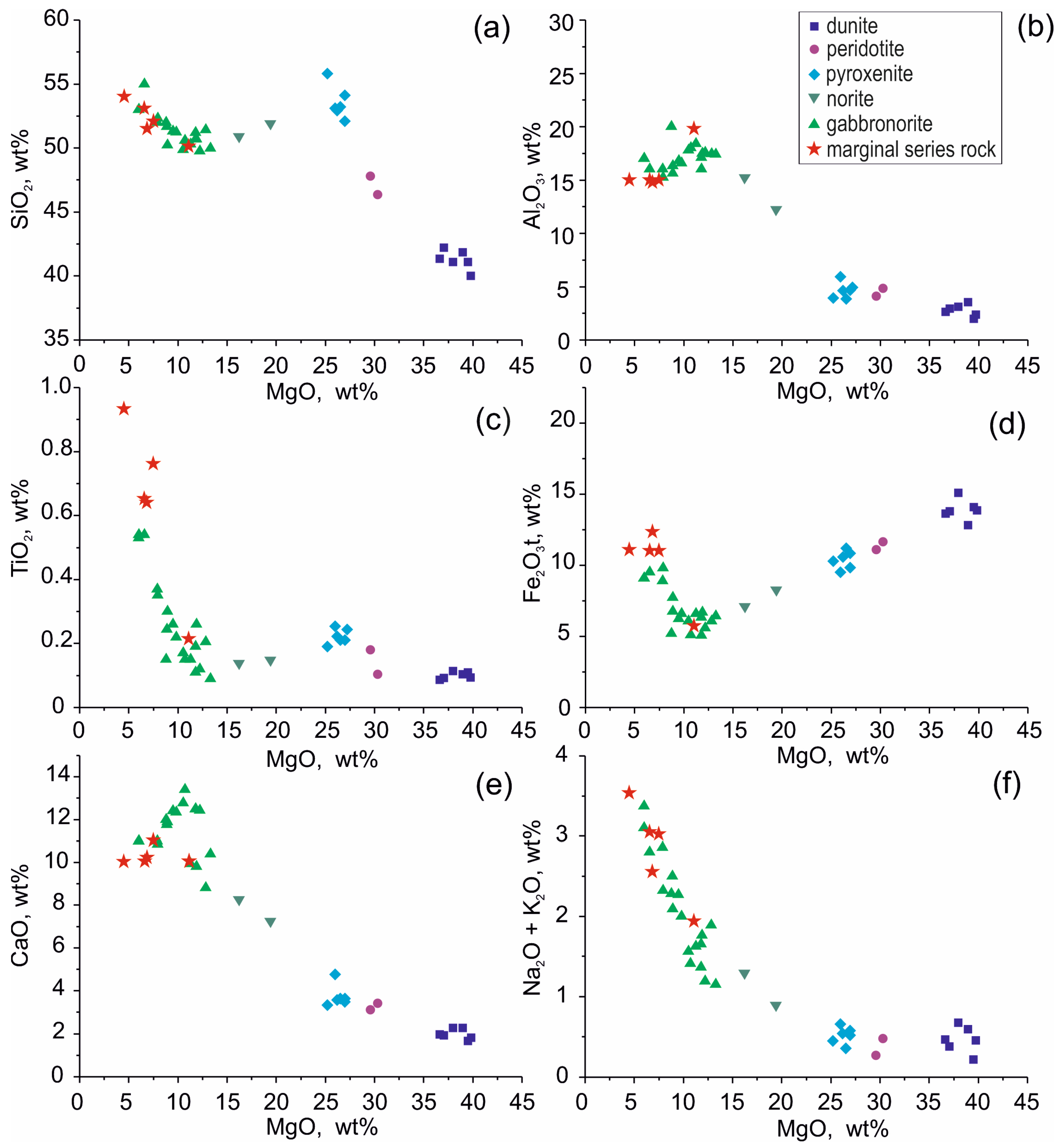
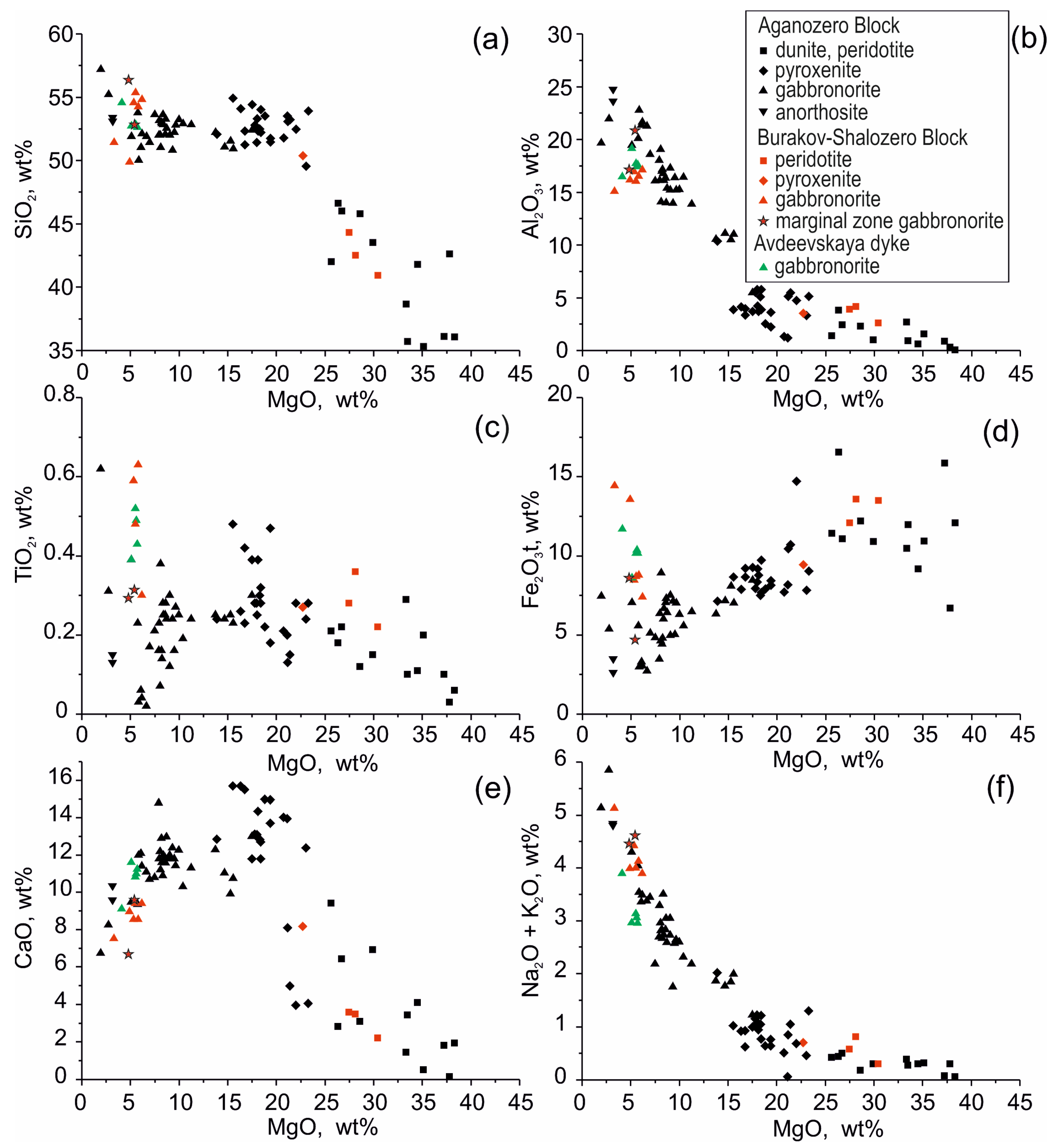

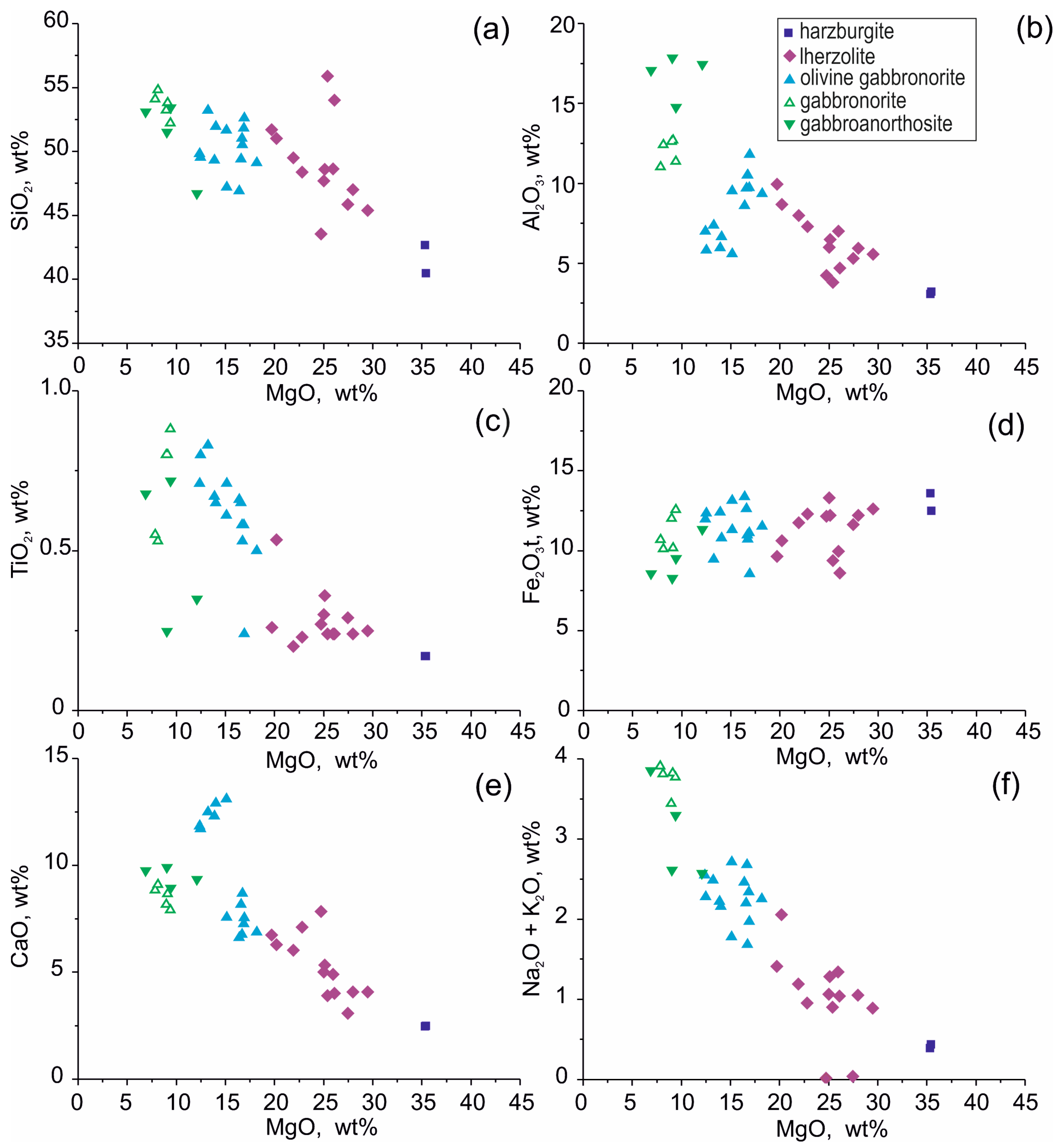
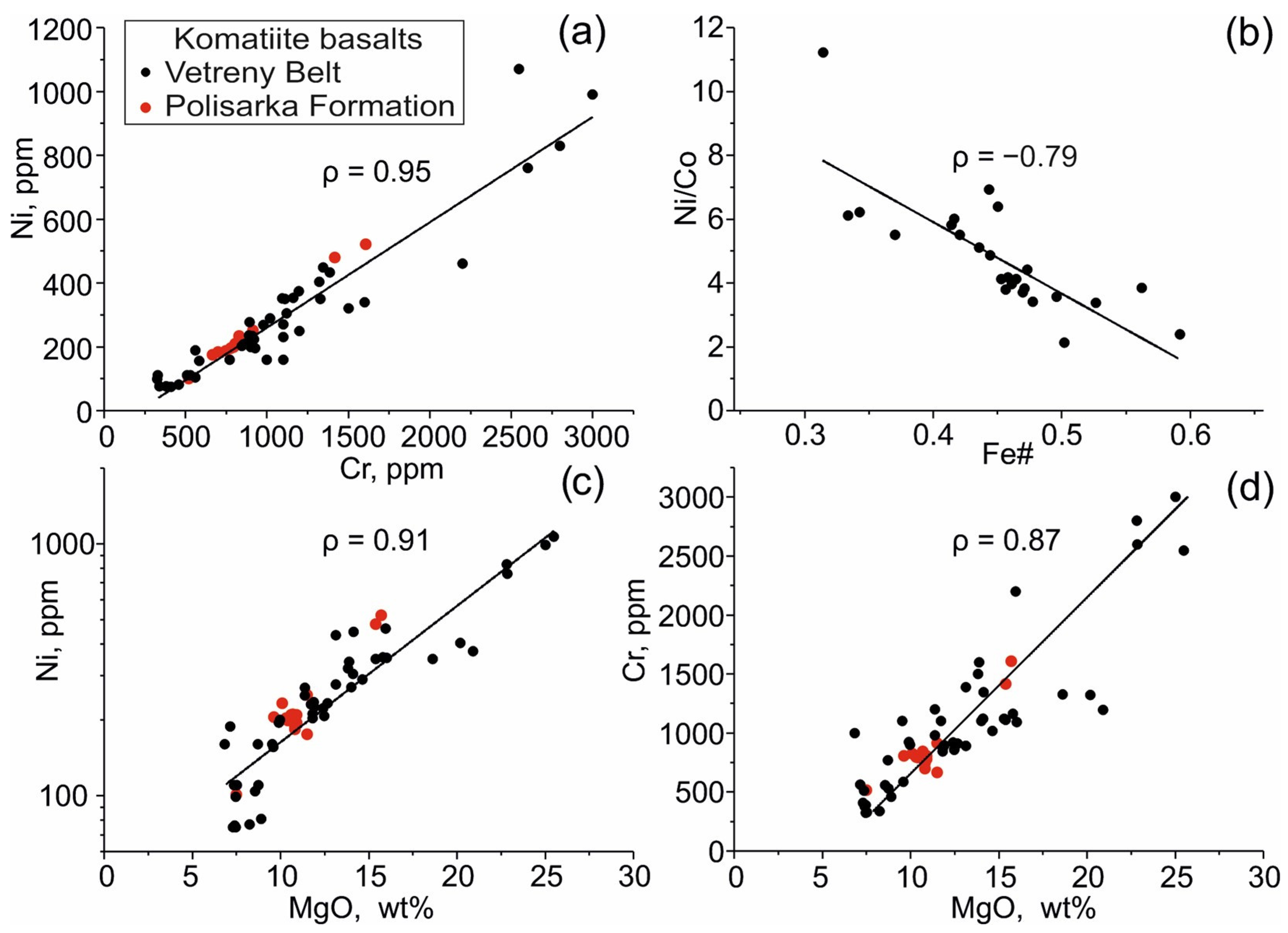
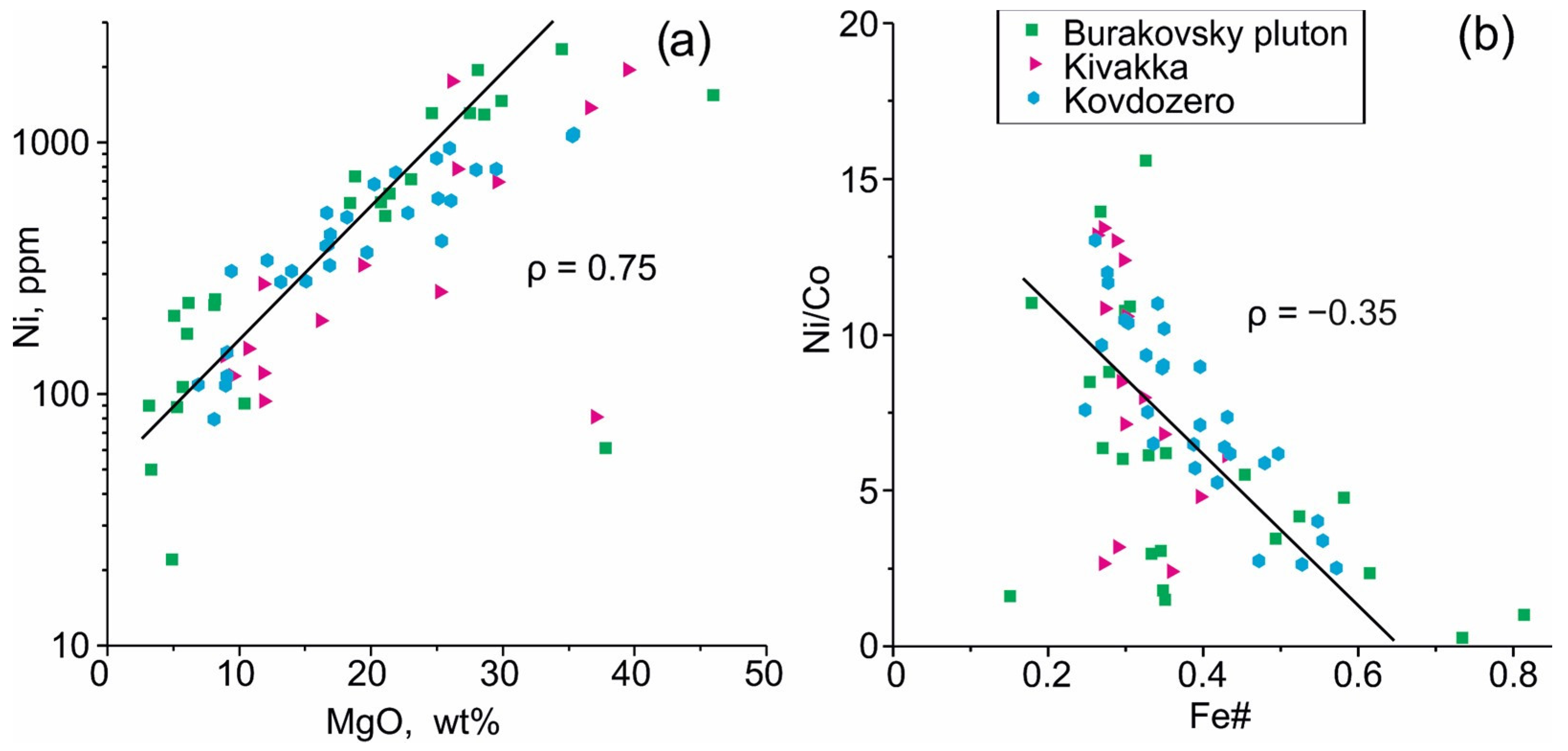
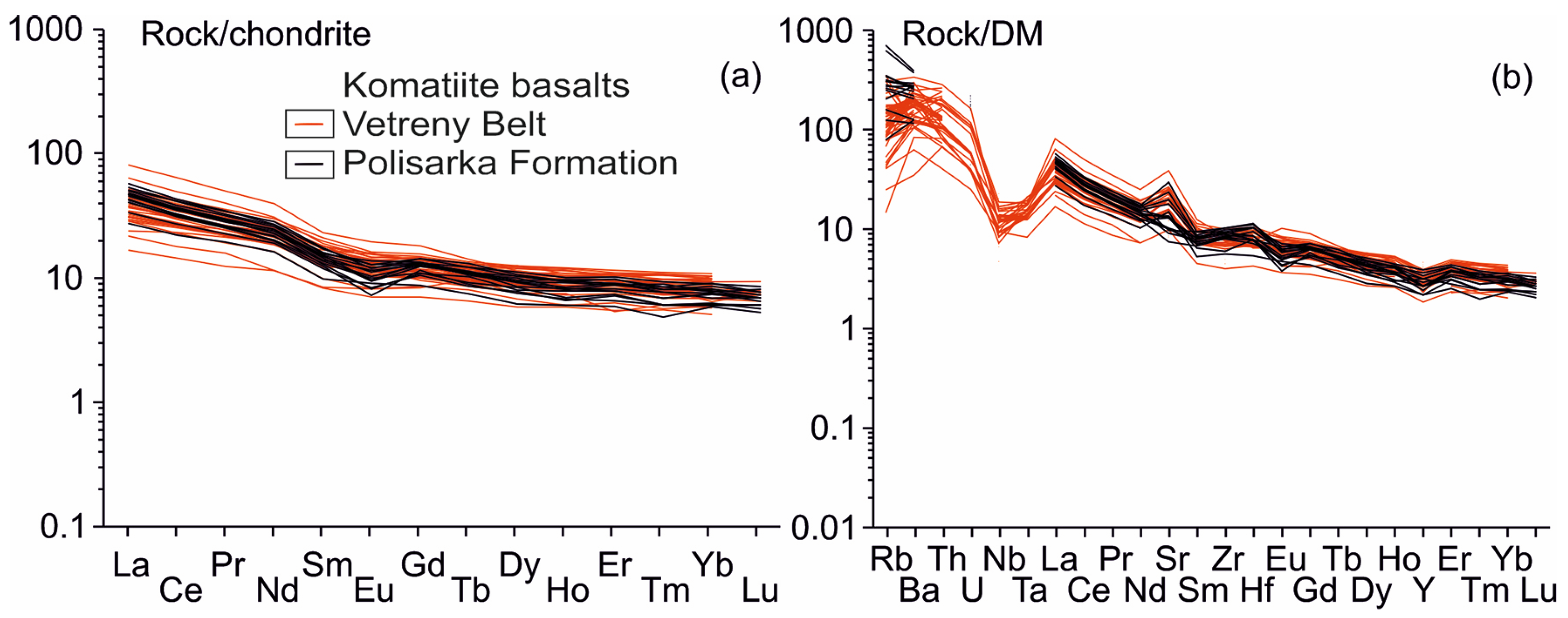
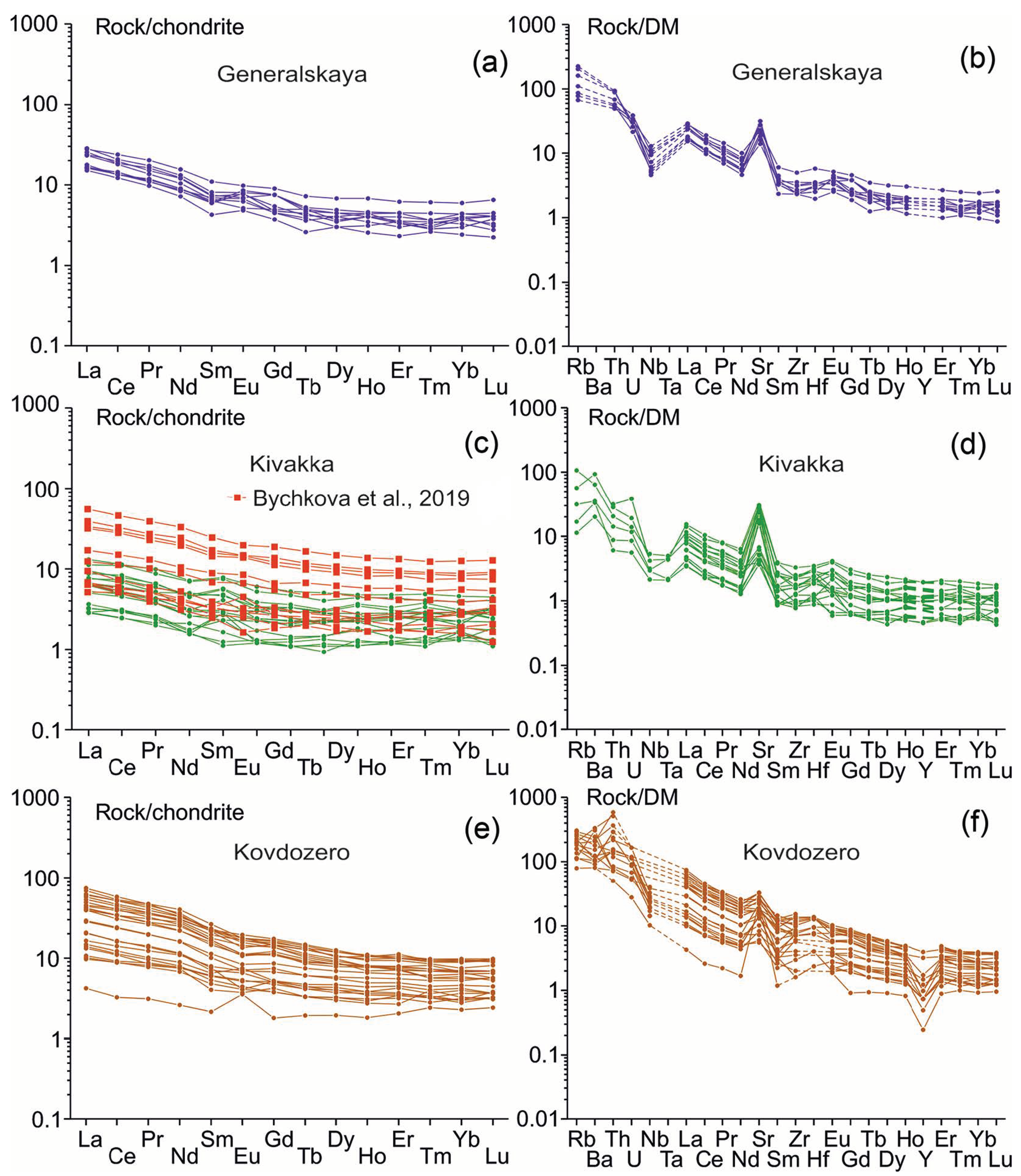
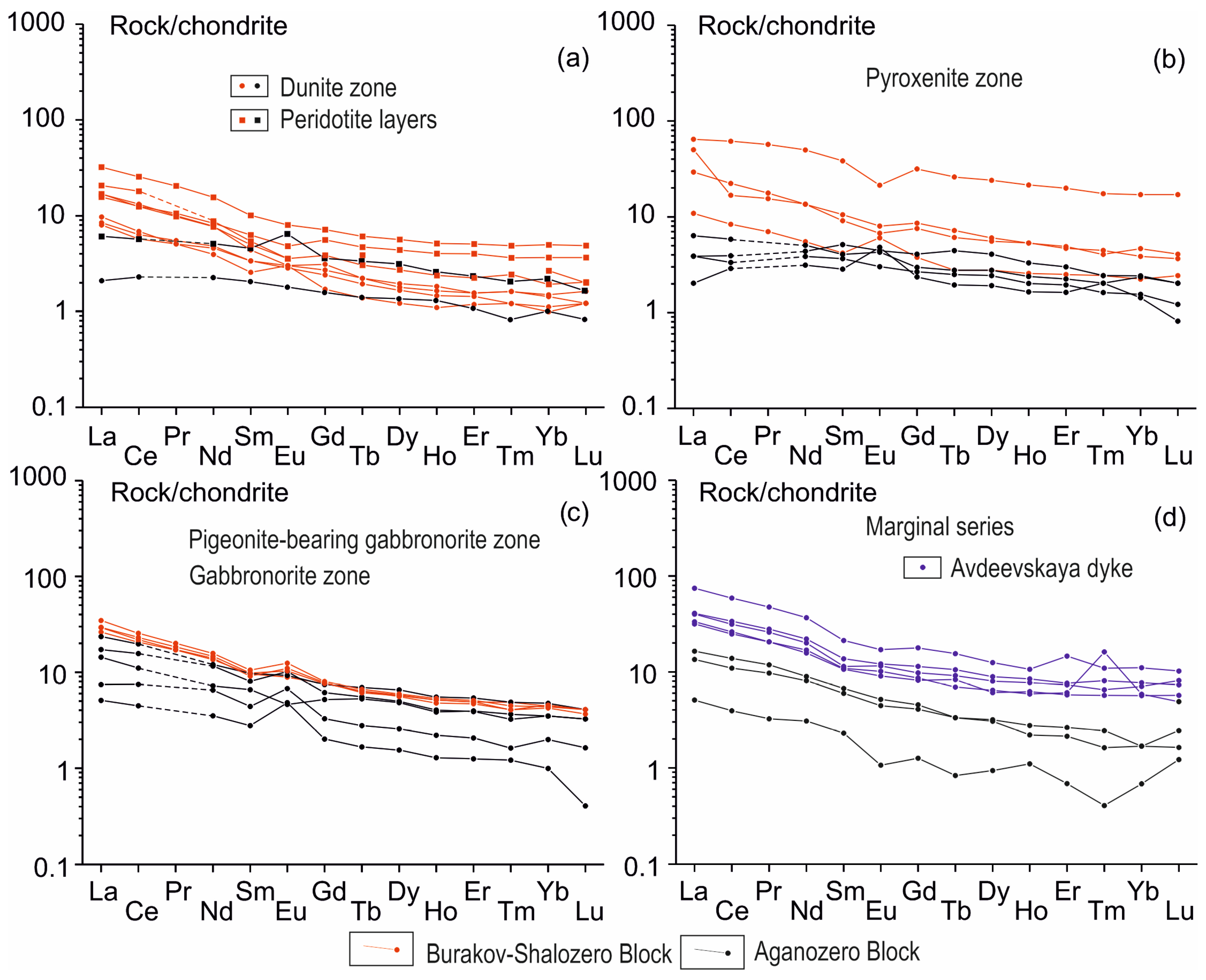
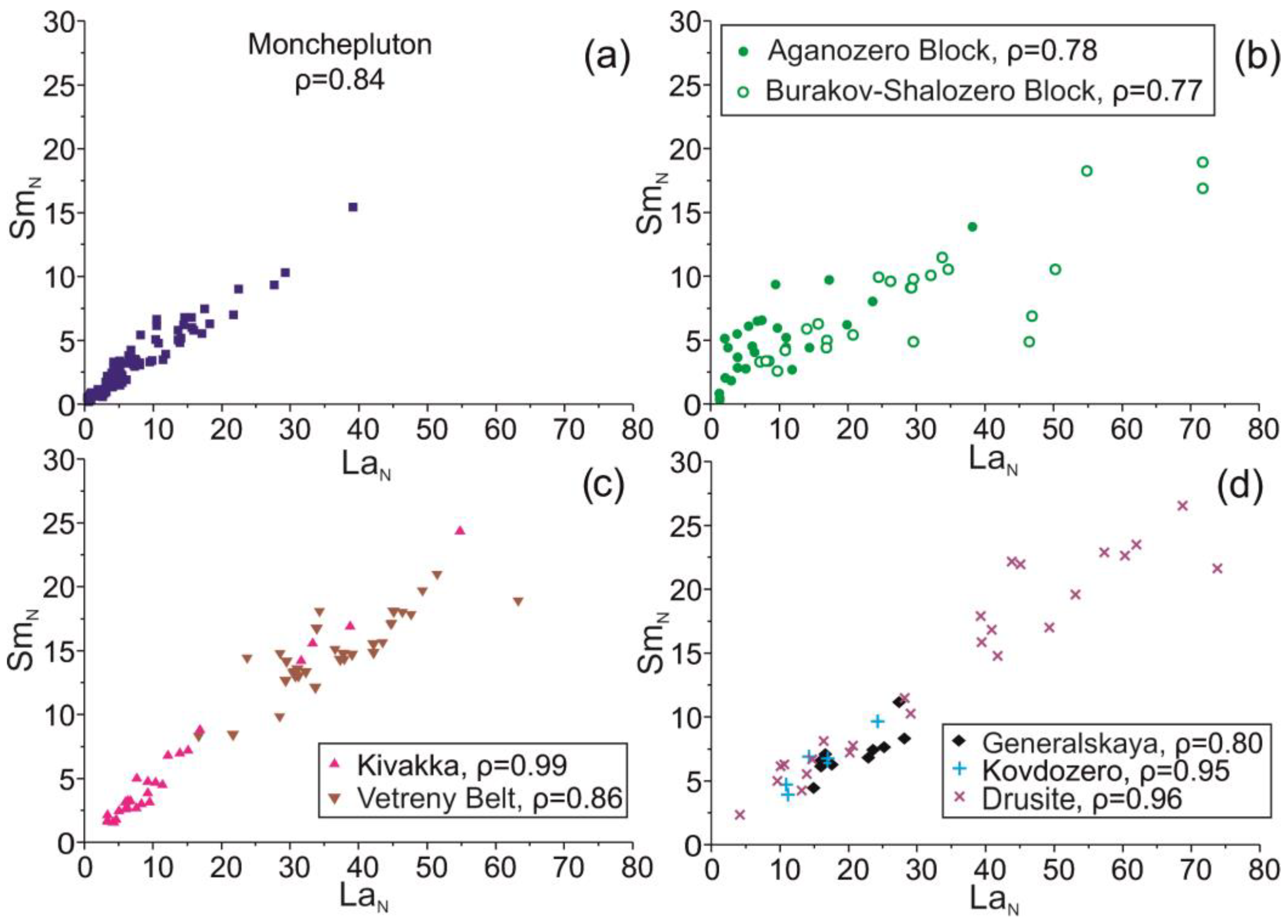


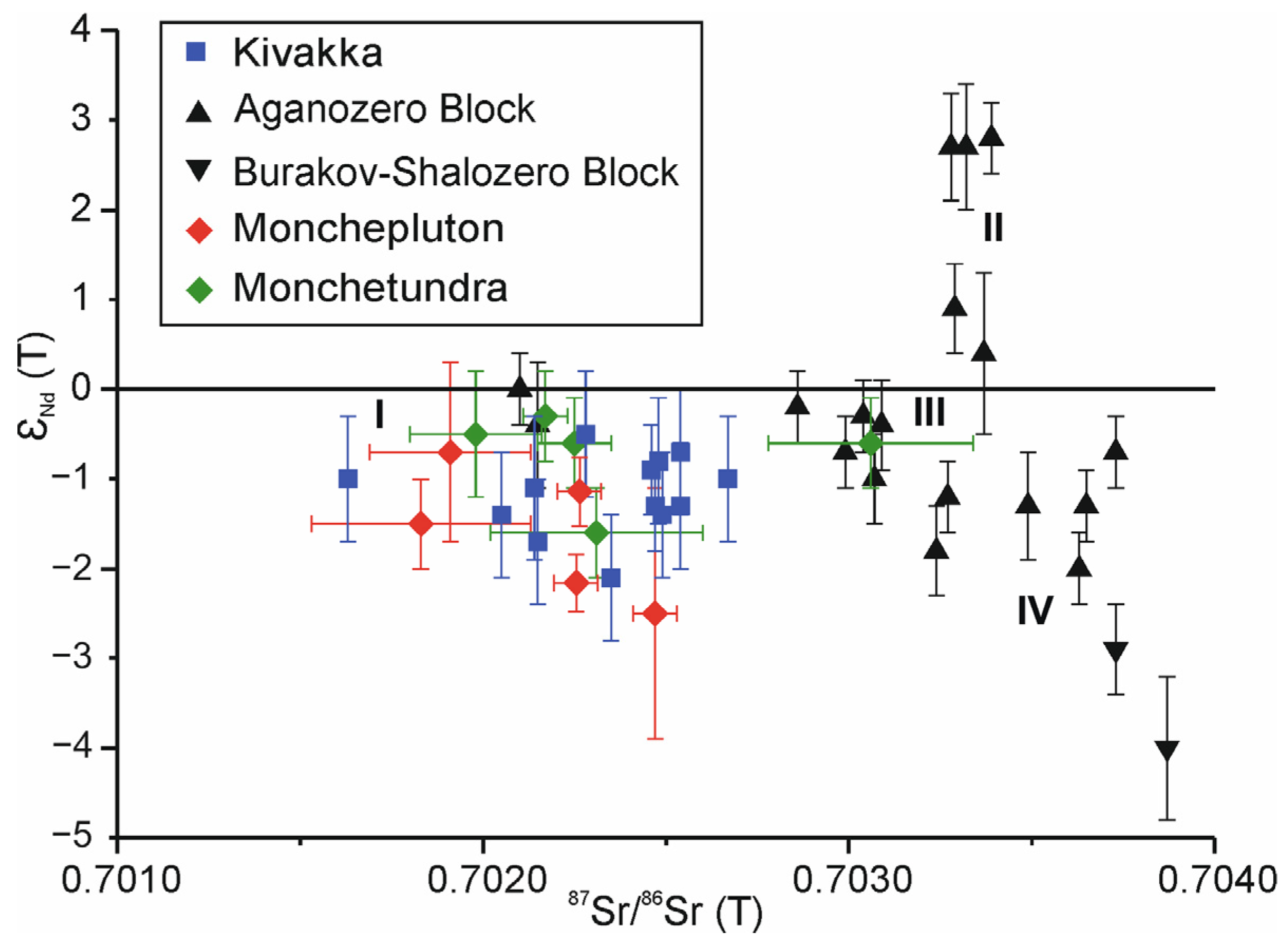
| Intrusion | Rock | U–Pb (Ma) | Sm–Nd (Ma) | Source |
|---|---|---|---|---|
| Mount Generalskaya | Gabbronorite | 2505.1 ± 1.6 | [13] | |
| Gabbronorite | 2496 ± 10 | [14] | ||
| Anorthosite | 2447 ± 10 | [14] | ||
| Gabbronorite | 2453 ± 42 | [15] | ||
| Kivakka | Gabbronorite | 2445 ± 2 | [15] | |
| Gabbronorite | 2445 ± 5 | [16] | ||
| Gabbronorite | 2420 ± 23 | [17] | ||
| Burakovsky pluton | Gabbronorite | 2449 ± 1.1 | [17] | |
| Gabbronorite | 2433 ± 4 * | [18] | ||
| Gabbronorite | 2430 ± 4 * | [18] | ||
| Pigeonite-bearing gabbronorite | 2433 ± 28 | [19] | ||
| Avdeevskaya dyke | Pigeonite-bearing gabbronorite | 2436 ± 46 | [19] | |
| Gabbro-pegmatite | 1999 ± 20 ** | Author | ||
| Kovdozero | Gabbro-pegmatite | 2436 ± 9 | [20] | |
| Lake Voronii | Anorthosite | 2460 ± 10 | Author | |
| Vetreny Belt, Mt. Golez | Komatiitic basalt | 2405 ± 5 | [21] | |
| Ruiga | Olivine-bearing gabbronorite | 2415 ± 5 | [22] |
Disclaimer/Publisher’s Note: The statements, opinions and data contained in all publications are solely those of the individual author(s) and contributor(s) and not of MDPI and/or the editor(s). MDPI and/or the editor(s) disclaim responsibility for any injury to people or property resulting from any ideas, methods, instructions or products referred to in the content. |
© 2023 by the authors. Licensee MDPI, Basel, Switzerland. This article is an open access article distributed under the terms and conditions of the Creative Commons Attribution (CC BY) license (https://creativecommons.org/licenses/by/4.0/).
Share and Cite
Smol’kin, V.F.; Mokrushin, A.V.; Chistyakov, A.V. Layered Intrusions of Paleoproterozoic Age in the Kola and Karelian Regions. Minerals 2023, 13, 597. https://doi.org/10.3390/min13050597
Smol’kin VF, Mokrushin AV, Chistyakov AV. Layered Intrusions of Paleoproterozoic Age in the Kola and Karelian Regions. Minerals. 2023; 13(5):597. https://doi.org/10.3390/min13050597
Chicago/Turabian StyleSmol’kin, Valery F., Artem V. Mokrushin, and Aleksey V. Chistyakov. 2023. "Layered Intrusions of Paleoproterozoic Age in the Kola and Karelian Regions" Minerals 13, no. 5: 597. https://doi.org/10.3390/min13050597
APA StyleSmol’kin, V. F., Mokrushin, A. V., & Chistyakov, A. V. (2023). Layered Intrusions of Paleoproterozoic Age in the Kola and Karelian Regions. Minerals, 13(5), 597. https://doi.org/10.3390/min13050597






